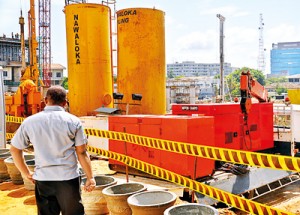SL economy in distress with debts and deficits, corrective policies yet to come
View(s):Sri Lanka is saddled with heavy debts compounded by widening deficits in the government budget and balance of payments. The total amount of external debt service commitments for the next 12 months is large, as much as three- fourths of the country’s foreign reserves. The budget is overburdened with heavy debt service payments which are estimated to be Rs.1,209 billion for this year accounting for three-fifths of total government revenue.

File picture of the Shangri-La project site
The fiscal deficit for this year is going to be much higher than 5.9 per cent of GDP as envisaged in the Budget 2016. It has become extremely difficult to bridge the deficit in the balance of payments due to the depletion of foreign reserves and capital outflows. The recent Fitch rating downgrade further blocks Sri Lanka’s foreign finance sources, as elaborated in last Sunday’s column.
Corrective policy actions that are being introduced seem too late and too little. After a long lapse, the Central Bank now allows some flexibility in exchange and interest rates in response to market realities. On the fiscal front, certain tax hikes were presented to the Parliament last Tuesday to raise government revenue.
It is the utmost responsibility of the government to take appropriate action to rectify the situation without further delay, instead of continuing to blame the previous regime for its financial malpractices which are well known by now.
‘Sudden stop’ episode begins
Easily accessible foreign borrowings during the last several years facilitated government-led infrastructure projects boosting economic growth. Increased market liquidity resulted from these capital inflows provided impetus to raise consumer demand as well. Low interest rates and overvalued exchange rate overheated the economy further. Thus, economic growth in the recent past was driven mainly by private consumption and debt-funded infrastructure development.
Sri Lanka now faces an episode of ‘sudden stop’ characterised by a large reduction in foreign capital inflows leading to a sharp economic downturn, high unemployment and widespread poverty. In this context, debt-dependent growth has become unsustainable.
 BOP in crisis
BOP in crisis
Unlike in the previous years, foreign capital inflows in 2015 were insufficient to meet the external current account deficit and hence, the overall balance of payments (BOP) recorded a deficit of US$1,489 million. Consequently, an equivalent amount of foreign reserves drained out to bridge the gap.
The BOP reflected the adverse repercussions of capital outflows from emerging market economies driven by expectation of US Fed rate hike last year which eventually took place in December.
The government securities market had a net foreign investment outflow of US$1,093 million while net capital inflows to the stock exchange was limited to US$4 million in 2015. In January this year, there were further net capital outflows amounting to US$118 million from the government securities market and US$19 million from the stock exchange. Foreign direct investment was only US$713 million in 2015.
The trade deficit is the dominant factor that continues to worsen the BOP. The trade deficit amounted to US$8,430 million in 2015 with exports amounting to US$10,505 million as against imports of US$18,934 million.
Export earnings were down by 5.6 per cent in 2015 as a result lower earnings from both industrial and agricultural exports.
Import outlays declined by 2.5 percent during the year largely on account of a reduction in the fuel import bill by US$2 billion. However, such saving was offset by a 22 per cent rise in consumer goods imports, mainly vehicles and other consumer durables.
BOP got further strained by a decline in worker remittances by 7 per cent last year reflecting the economic setback in oil producing countries due to the dramatic fall in crude oil prices.
Fiscal debacle
Budget 2016 eventually became a non-starter with many proposals being abandoned, and it is still not clear which budget proposals remain effective. Reportedly, the amendments effected to the revenue proposals in Budget 2016 caused a revenue loss of Rs. 70 – 80 billion. Reintroduction of concessionary vehicle permits and reduction of vehicle emission levy alone brought down the estimated revenue by Rs. 66 billion.
The recurrent and capital expenditure is reported to have increased over and above the projected targets in Budget 2016 due to erroneous data and hidden debt liabilities.
Tax hikes but no expenditure cuts
The Prime Minister presented several tax proposals to the Parliament last Tuesday with a view to minimise the impact of the global downturn on the Sri Lankan economy and to clean up the colossal liabilities of public sector institutions.
They are to (a) increase Value Added Tax to a flat rate of 15 per cent, (b) suspend the corporate and non-corporate tax proposal in the Budget 2016 for two years, (c) raise corporate tax rate to 17.5 per cent instead of the 15 per cent rate proposed in the Budget 2016, (d) reintroduce the Capital Gains Tax, and (f) keep the rate of Nations Building Tax at 2 per cent instead of raising it to 4 per cent as proposed in Budget 2016.
Thus, these proposals have reversed several previous tax proposals included in the Budget 2016.
Once again, these new proposals were presented to the Parliament by the PM but not by the Finance Minister. This proves again that the Finance Ministry is fast losing its grip in handling fiscal affairs, as mentioned in this column last Sunday.
These proposals seem to be selective tax increases hastily prepared just to satisfy the IMF for a stand-by arrangement, rather than broad-based fiscal reforms geared to address the deep-rooted budgetary problems.
The fiscal imbalance is not only due to low tax revenue but also due to high government expenditure. Restructuring of expenditure with curtailments of extravagant public sector outlays, therefore, is essential to reduce the budget deficit. No attempt has been made to address this problem even at this eleventh hour.
Growth slowdown is likely
High GDP growth during the last several years was driven by the non-tradable sector manifested by locally-rendered services, mainly construction, transport, domestic trade and banking. These activities are likely to shrink due to contractionary fiscal and monetary policies combined with foreign exchange shortages.
The proposed increases in the rates of VAT and corporate taxes and re-introduction of capital gains tax will have negative effects on the aggregate demand. The news about the imposition of a Capital Gains Tax is reported to have already sent negative sentiments to the stock market with the All Share Price Index (ASPI) falling below the 6,000 mark last Tuesday for the first time since April 2014.
Meanwhile, the upward movements in market interest rates following the Central Bank’s decision to raise its Statutory Reserve Ratio and Policy Rates tend to reduce market liquidity and consumer demand, and thereby to reduce pressure on BOP.
The planned infrastructure projects, mainly the Megapolis project linked with the envisaged naval, air, transport, financial and supply services are to be the major drivers of economic growth, according to the government’s economic policy plan.
The funding of these mega-projects will be constrained by the precarious economic situation with high debt commitments and capital outflows, as signaled by the recent Fitch rating downgrade. All these factors point to an economic downturn.
(The writer, an economist, academic and former central banker, can be reached at sscolom@gmail.com)


